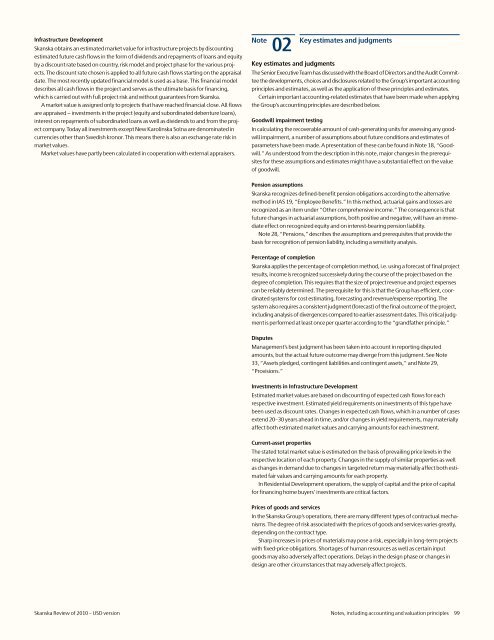Review of 2010 â USD version - Skanska
Review of 2010 â USD version - Skanska
Review of 2010 â USD version - Skanska
Create successful ePaper yourself
Turn your PDF publications into a flip-book with our unique Google optimized e-Paper software.
Infrastructure Development<br />
<strong>Skanska</strong> obtains an estimated market value for infrastructure projects by discounting<br />
estimated future cash flows in the form <strong>of</strong> dividends and repayments <strong>of</strong> loans and equity<br />
by a discount rate based on country, risk model and project phase for the various projects.<br />
The discount rate chosen is applied to all future cash flows starting on the appraisal<br />
date. The most recently updated financial model is used as a base. This financial model<br />
describes all cash flows in the project and serves as the ultimate basis for financing,<br />
which is carried out with full project risk and without guarantees from <strong>Skanska</strong>.<br />
A market value is assigned only to projects that have reached financial close. All flows<br />
are appraised − investments in the project (equity and subordinated debenture loans),<br />
interest on repayments <strong>of</strong> subordinated loans as well as dividends to and from the project<br />
company. Today all investments except New Karolinska Solna are denominated in<br />
currencies other than Swedish kronor. This means there is also an exchange rate risk in<br />
market values.<br />
Market values have partly been calculated in cooperation with external appraisers.<br />
Note<br />
02<br />
Key estimates and judgments<br />
Key estimates and judgments<br />
The Senior Executive Team has discussed with the Board <strong>of</strong> Directors and the Audit Committee<br />
the developments, choices and disclosures related to the Group’s important accounting<br />
principles and estimates, as well as the application <strong>of</strong> these principles and estimates.<br />
Certain important accounting-related estimates that have been made when applying<br />
the Group’s accounting principles are described below.<br />
Goodwill impairment testing<br />
In calculating the recoverable amount <strong>of</strong> cash-generating units for assessing any goodwill<br />
impairment, a number <strong>of</strong> assumptions about future conditions and estimates <strong>of</strong><br />
parameters have been made. A presentation <strong>of</strong> these can be found in Note 18, “Goodwill.”<br />
As understood from the description in this note, major changes in the prerequisites<br />
for these assumptions and estimates might have a substantial effect on the value<br />
<strong>of</strong> goodwill.<br />
Pension assumptions<br />
<strong>Skanska</strong> recognizes defined-benefit pension obligations according to the alternative<br />
method in IAS 19, “Employee Benefits.” In this method, actuarial gains and losses are<br />
recognized as an item under “Other comprehensive income.” The consequence is that<br />
future changes in actuarial assumptions, both positive and negative, will have an immediate<br />
effect on recognized equity and on interest-bearing pension liability.<br />
Note 28, “Pensions,” describes the assumptions and prerequisites that provide the<br />
basis for recognition <strong>of</strong> pension liability, including a sensitivity analysis.<br />
Percentage <strong>of</strong> completion<br />
<strong>Skanska</strong> applies the percentage <strong>of</strong> completion method, i.e. using a forecast <strong>of</strong> final project<br />
results, income is recognized successively during the course <strong>of</strong> the project based on the<br />
degree <strong>of</strong> completion. This requires that the size <strong>of</strong> project revenue and project expenses<br />
can be reliably determined. The prerequisite for this is that the Group has efficient, coordinated<br />
systems for cost estimating, forecasting and revenue/expense reporting. The<br />
system also requires a consistent judgment (forecast) <strong>of</strong> the final outcome <strong>of</strong> the project,<br />
including analysis <strong>of</strong> divergences compared to earlier assessment dates. This critical judgment<br />
is performed at least once per quarter according to the “grandfather principle.”<br />
Disputes<br />
Management’s best judgment has been taken into account in reporting disputed<br />
amounts, but the actual future outcome may diverge from this judgment. See Note<br />
33, “Assets pledged, contingent liabilities and contingent assets,” and Note 29,<br />
“Provisions.”<br />
Investments in Infrastructure Development<br />
Estimated market values are based on discounting <strong>of</strong> expected cash flows for each<br />
respective investment. Estimated yield requirements on investments <strong>of</strong> this type have<br />
been used as discount rates. Changes in expected cash flows, which in a number <strong>of</strong> cases<br />
extend 20–30 years ahead in time, and/or changes in yield requirements, may materially<br />
affect both estimated market values and carrying amounts for each investment.<br />
Current-asset properties<br />
The stated total market value is estimated on the basis <strong>of</strong> prevailing price levels in the<br />
respective location <strong>of</strong> each property. Changes in the supply <strong>of</strong> similar properties as well<br />
as changes in demand due to changes in targeted return may materially affect both estimated<br />
fair values and carrying amounts for each property.<br />
In Residential Development operations, the supply <strong>of</strong> capital and the price <strong>of</strong> capital<br />
for financing home buyers’ investments are critical factors.<br />
Prices <strong>of</strong> goods and services<br />
In the <strong>Skanska</strong> Group’s operations, there are many different types <strong>of</strong> contractual mechanisms.<br />
The degree <strong>of</strong> risk associated with the prices <strong>of</strong> goods and services varies greatly,<br />
depending on the contract type.<br />
Sharp increases in prices <strong>of</strong> materials may pose a risk, especially in long-term projects<br />
with fixed-price obligations. Shortages <strong>of</strong> human resources as well as certain input<br />
goods may also adversely affect operations. Delays in the design phase or changes in<br />
design are other circumstances that may adversely affect projects.<br />
<strong>Skanska</strong> <strong>Review</strong> <strong>of</strong> <strong>2010</strong> – <strong>USD</strong> <strong>version</strong> Notes, including accounting and valuation principles 99

















